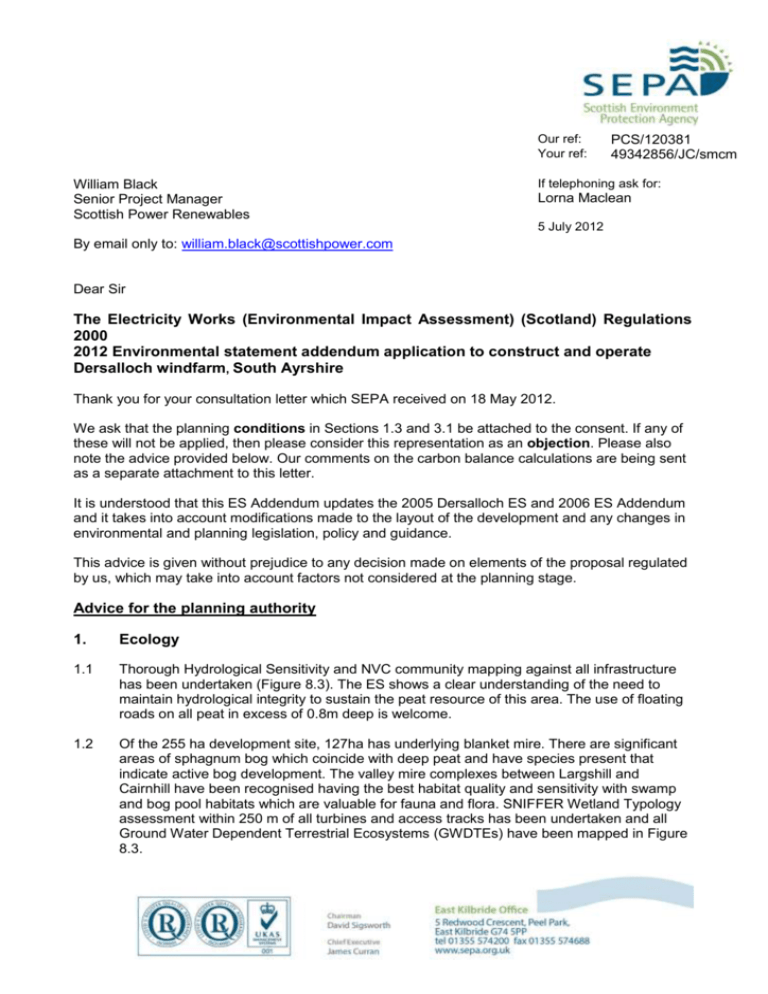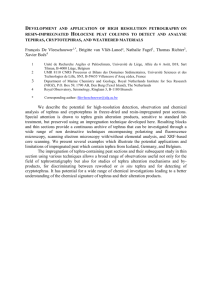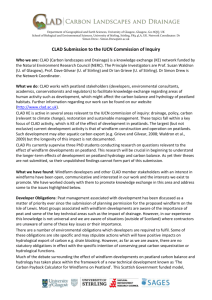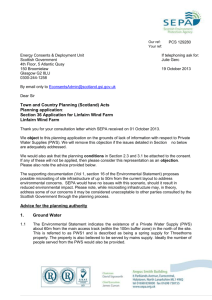4. Regulatory requirements
advertisement

Our ref: Your ref: William Black Senior Project Manager Scottish Power Renewables PCS/120381 49342856/JC/smcm If telephoning ask for: Lorna Maclean 5 July 2012 By email only to: william.black@scottishpower.com Dear Sir The Electricity Works (Environmental Impact Assessment) (Scotland) Regulations 2000 2012 Environmental statement addendum application to construct and operate Dersalloch windfarm, South Ayrshire Thank you for your consultation letter which SEPA received on 18 May 2012. We ask that the planning conditions in Sections 1.3 and 3.1 be attached to the consent. If any of these will not be applied, then please consider this representation as an objection. Please also note the advice provided below. Our comments on the carbon balance calculations are being sent as a separate attachment to this letter. It is understood that this ES Addendum updates the 2005 Dersalloch ES and 2006 ES Addendum and it takes into account modifications made to the layout of the development and any changes in environmental and planning legislation, policy and guidance. This advice is given without prejudice to any decision made on elements of the proposal regulated by us, which may take into account factors not considered at the planning stage. Advice for the planning authority 1. Ecology 1.1 Thorough Hydrological Sensitivity and NVC community mapping against all infrastructure has been undertaken (Figure 8.3). The ES shows a clear understanding of the need to maintain hydrological integrity to sustain the peat resource of this area. The use of floating roads on all peat in excess of 0.8m deep is welcome. 1.2 Of the 255 ha development site, 127ha has underlying blanket mire. There are significant areas of sphagnum bog which coincide with deep peat and have species present that indicate active bog development. The valley mire complexes between Largshill and Cairnhill have been recognised having the best habitat quality and sensitivity with swamp and bog pool habitats which are valuable for fauna and flora. SNIFFER Wetland Typology assessment within 250 m of all turbines and access tracks has been undertaken and all Ground Water Dependent Terrestrial Ecosystems (GWDTEs) have been mapped in Figure 8.3. 1.3 The mitigation cited to avoid the most sensitive areas is welcome and necessary. An ecological Clerk of works is proposed and must be involved during every point of construction to further micro-site where needed, close to these sensitive GWDTE’s. Hydrological connectivity has been considered at each turbine and turbines have been relocated accordingly. This is welcome and is best practice. It would be ideal if such mitigation including permeable road surfaces, floating roads, micro-siting and hydrological connectivity drainage routes, could be conditioned through planning as a necessary requirement. 1.4 The ART fishery studies show that several of the tributaries within the development area sustain healthy brown trout populations and thus have good water quality, particularly the Shalloch Burn, Baing Burn and Lambdoughty Burn. The trout populations here are vulnerable due to their isolation (upstream migration prevented by impassable falls) and could easily be wiped out by pollution incidents on site. The Pollution Prevention Plan and the water quality monitoring programme included in the Integrated Management Plan (IMP) is cited as an intention as requested by SEPA. However, the details of this monitoring plan do no state that macro-invertebrate survey work will be included in the suit of parameters assessed. The detail of this monitoring plan must be provided to approve the sampling locations. Macro-invertebrate survey work prior to and post construction on at least the watercourses mentioned above, must be included in this plan. 1.5 As the Straiton Hill Provisional Wildlife site is located within the development, the consideration given in paragraph 241 (section 8.10.3) to a Conservation Management Plan (that would define grazing regimes and other such habitat enhancement techniques) should be encouraged, thus recognising the overall value of this area of land to the local environment. SEPA would favourably view a Conservation Management Plan coupled with prescribed mitigation. 2. Peat Management 2.1 It is noted that the proposed windfarm has been designed to minimise the excavation of peat. The draft Peat Management Plan clearly sets out the peat excavation and reuse volumes. There appears to be sufficient appropriate reuse options in the restoration of the site and the draft plan has closely followed Scottish Renewables and SEPA (January 2012) “Guidance on the assessment of peat volumes, reuse of excavated peat and the minimisation of waste”. We welcome the production of a Final Peat Management Plan informed by further site investigation. 3. Water Environment 3.1 It is noted that the development will have an Integrated Management Plan (IMP) which will incorporate a Pollution Prevention Plan, Monitoring Plan and Method Statements to cover groundwater and surface water protection. We would ask that a condition is attached to any permission granted requiring the submission of an IMP including details on drainage arrangements and other aspects of pollution prevention. When drawing up the IMP the guidance in “Good Practice during windfarm construction” a joint working group publication, should be followed. 3.2 In general we would prefer developments to minimise the number of watercourse crossings/diversions. However it is noted that the number of crossings has been increased since the original layout to avoid construction on steep slopes and minimise the risk of peat slide. SEPA’s “Good Practice Guide – River Crossings” should be followed when designing crossings. Regulatory advice 4. Regulatory requirements 4.1 Details of regulatory requirements and good practice advice for the applicant can be found on our website at www.sepa.org.uk/planning.aspx. If you are unable to find the advice you need for a specific regulatory matter, please contact a member of the operations team in your local SEPA office at: 31 Miller Road Ayr KA7 2AX If you have any queries relating to this letter, please contact me by telephone on 01355 574 200 or e-mail at planning.ek@sepa.org.uk. Yours faithfully Lorna Maclean Senior Planning Officer Planning Service Copy to: Jean Curran Associate Director URS Infrastructure & Environment UK Limited 23 Chester Street Edinburgh EH3 7EN











